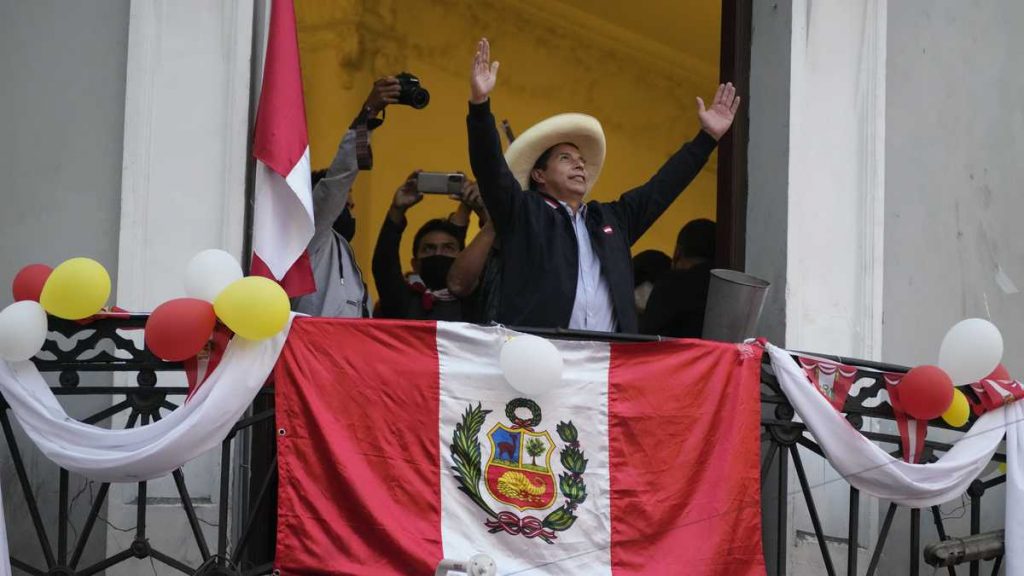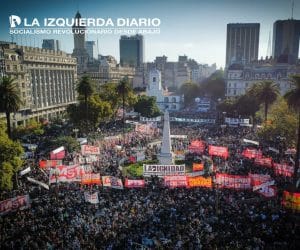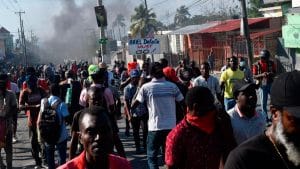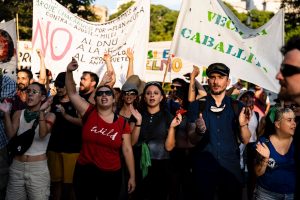Peru’s June 6 runoff election, which resulted in Pedro Castillo’s victory over Keiko Fujimori, was marked by intense polarization. The contending social sectors were those that want fundamental change and those seeking to maintain their privileges and the order established by the neoliberal constitution of 1993. This polarization results from the profound economic, health, and political crisis that has been intensified by the coronavirus pandemic, and it is associated with the exhaustion of neoliberalism on a national and international scale. Castillo’s victory marks the beginning of a new and still unpredictable period, in which this struggle between change and continuity will undoubtedly play an important role.
Signs of this polarization have spread throughout the country. Thousands of Castillo’s followers took to the streets when they learned that the National Electoral Council had issued a ruling, which it later retracted, postponing the deadlines for challenging the votes cast at some polling stations, thereby creating the conditions for a fraudulent win by Fujimori. A few days before, Fujimori had organized a protest in Lima, with the support of the mass media, rejecting the results of the runoff and criticizing the supposedly communist policies promoted by Castillo and his followers, who are constant targets of their racial and class-based discrimination.
How Did We End Up in This Situation? The Preelection Context
The electoral process took place in the context of a deep economic and health crisis caused by the Covid-19 pandemic, which has resulted in almost 190,000 deaths, together with 6 million unemployed workers, as reported by the Peruvian Institute of Economics (IPE). This situation is compounded by a profound crisis of the political regime, which has led the country’s institutions to be delegitimized, along with political parties and important political figures. This political crisis, which is an expression of the country’s organic crisis, began in late 2016 when the links between leaders and Odebrecht’s businesses became public. This would lead to the fall of Pedro Pablo Kuczynski, who was succeeded by Vizcarra, the suicide of APRA leader Alan García, and the imprisonment of former president Ollanta Humala; his wife, Nadine Heredia; and the former mayor of Lima Susana Villaran, among other public figures who have joined the already-imprisoned Alberto Fujimori and Alejandro Toledo, who is now a fugitive in the United States, under investigation for corruption. Vizcarra would later fall owing to his shady ties with construction companies, and Manuel Merino — who would replace him as president — was also forced to resign in November 2020 by the explosive protests against the parliament’s actions and against the political parties that brought Merino to power.
The root cause of this organic crisis is the ruling class’s inability to maintain the neoliberal model, which has shown signs of exhaustion not only nationally but across the South American continent. This has led to massive protests in Chile, Ecuador, and Colombia, where the common denominator has been the rejection of the austerity policies imposed under the Washington Consensus. The “great failed enterprise” of neoliberalism, using Gramsci’s terms, has thus led to the governments’ inability to establish hegemony or a consensus, resulting in a crisis of the state as a whole and of the political and ideological forms of organization of the ruling class. Moreover, this has led to extreme political fragmentation and hampered the bourgeois parties capacity to build stable coalitions at the state level. As a result, there have been constant conflicts in recent years between the executive and legislative branches in Peru. These conflicts peaked in late 2020, when the parliament, with a neoliberal majority, removed the neoliberal president Martin Vizcarra from office.
The political crisis has intensified in parallel with a rise in workers’ and popular struggles, as a result of the impact of the international economic crisis. In 2017 this situation led to large, forceful miners’ strikes in the southern macro-region of Peru, at the Southern, Cerro Verde and San Juan de Chorunga mines, among others. The explosive situation also led to a powerful teachers’ strike, in which Pedro Castillo emerged for the first time as a leader. The teachers had launched a three-month strike against the educational and punitive policies of Pedro Pablo Kuczynski’s government and the corrupt union bureaucracy of Patria Roja. At the same time, large protests had taken place nationwide against the pardoning of Alberto Fujimori and the corruption of the political class, which would lead to demands for an end to the political constitution of 1993 and the drafting of a new constitution by a Constituent Assembly.
During 2020 and the first half of 2021, there have been massive health workers’ protests against job insecurity and for full workers’ rights. In December 2020 and January 2021, the agricultural workers of Ica and northern Peru launched a major strike against the agricultural labor regulations that make it legal for laborers to work 12 hours a day or more, with minimum wages and no job stability. But the protests that have had the greatest political impact during this period were the youth protests of November 2020 against Merino’s illegitimate government. He was forced to resign after a week of intense demonstrations, which the police brutally repressed. This struggle led to renewed demands for an end to the 1993 constitution by the establishment of a Constituent Assembly. Yet, with the support of the mass media and the complicity of the reformist and neoreformist Left and the union bureaucracy, the bourgeoisie was able to channel the people’s anger through the country’s institutions under the administration of Francisco Sagasti, who was appointed president by the Congress, while Mirtha Vázques of the Broad Front became president of the parliament.
During the November protests two young students, Brayan and Inti, were killed by the police. And during the December agricultural workers’ strike, three farm workers were killed by the police. The perpetrators of these crimes and those politically responsible have not been investigated, let alone convicted.
The Constitutional Court played an active role in terminating measures that partially favored workers, like the withdrawal of pension funds or the elimination of precarious working conditions in the health sector. In the latter case, the Constitutional Court ruled that it was unconstitutional to eliminate these conditions because the state lacked sufficient resources to pay for workers’ salaries. The state did, however, manage to find millions of dollars to bail out businesses under the “Peru Reactivation” plan. This showed, once again, that the “balance and independence of powers” promoted by politicians and technocrats at the service of the bourgeoisie is actually a mechanism of capitalist democracy, one that serves to halt any attempt to even partially affect corporate profits. Thus, government bodies like the Constitutional Court constantly act to preserve the status quo.
This situation was aggravated by the Vaccinegate scandal, which showed the corruption among the political class and the country’s massive inequality. While former president Vizcarra, his ministers, the owners of pharmaceutical companies, journalists, union bureaucrats, and other close associates of the executive were able to skip the vaccine line, thousands of people, especially among the sectors that had been most affected by the economic crisis, were infected daily and died mostly from a shortage of medical oxygen and basic resources to manage the pandemic, such as ventilators and ICU beds. There was, moreover, no mass testing. The actual statistics were recently released, indicating a death toll of 187,000. Meanwhile, massive profits were reaped by the owners of private health care businesses (clinics, pharmaceutical companies, drug store chains, production sites, and medical oxygen suppliers). They achieved this by jacking up the prices of their products with the approval of the state and successive administrations.
The Runoff between Castillo and Keiko
These are some of the factors that created the context for the April 11 election and the June 6 runoff. The elections took place in the context of a profound crisis of the political regime, resulting in an extremely low voter turnout in the runoff election, with 19.099 percent of the votes going to Pedro Castillo and 13.368 percent to Keiko Fujimori. Neither candidate garnered more than 20 percent of the valid votes, while more than 40 percent of voters either cast invalid or blank votes or did not participate. As a result the extreme fragmentation among Peru’s political parties, 18 candidates participated in the first round of the presidential election.
Castillo ran with Peru Libre, led by Vladimir Cerrón (who was originally a Stalinist and has been involved in corruption scandals). He carried out a solid campaign in support of the teachers’ union, from which he emerged as a national leader during the strike in 2017. Castillo ran in the first round on a platform of tepid reforms, which was in many ways conservative, ignoring the demands of women and sexual minorities. His program, however, questioned some aspects of the country’s neoliberal policies and the actions of institutions like the Constitutional Court and the Ombudsman’s Office (which, as we have seen, are part of the mechanisms used to maintain the status quo). He also promised to change the 1993 constitution through a Constituent Assembly so that “the wealth of the nation can belong to all Peruvians,” which was reflected in his campaign slogan: “No more poor people in a rich country.”
By promoting these policies and organizing rallies in the poorest regions in the country’ interior, Castillo started to penetrate the sectors that have been hardest hit by the crisis, who began to see him as an alternative to the rest of politicians, who are instantly associated with continuing austerity and corruption. As a result, in the last stretch of the first round, he went from being in one of the last places to disputing first place. He gradually came to represent the indignation of the oppressed, workers, and peasants, mostly from the interior, who have seen their living conditions worsen as a result of different governments’ austerity policies.
Castillo could thus wrest the leadership of the Left from the hands of Verónika Mendoza, who, until weeks before April 11, was one of the most likely candidates to participate in the runoff. Mendoza’s support for Kuczynski in the 2016 runoff, for Vizcarra’s administration, and, more recently, for Sagasti, in order to “preserve the country’s institutions,” apparently led the electorate to perceive her as part of the regime’s old guard.
And Keiko Fujimori did not seem to have a good chance of winning during the first round, given that she is under investigation for having received illegal campaign contributions from Odebrecht and other companies, was even preventively detained three times. Despite this, she ended up in second place, with a meager 13 percent, thanks to the help of her large party apparatus and the delegitimization of the other right-wing candidates. During her campaign, she adopted the populist image that had characterized her father, Alberto Fujimori, during his administration. She promised to crack down on common crime, joined with right-wing sectors critical of the administrations of Kuczynski, Vizcarra, and Sagasti, and promised business leaders that she would preserve the pillars of the 1993 political regime founded by her father. These promises and the weakness of her opponents were enough to take her to the runoff.
The Runoff and the Country’s Political Polarization
When it was announced that Fujimori would face off against Castillo in the runoff, political figures like Rafael López Aliaga, Cesar Acuña, Mario Vargas Llosa, Hernando de Soto, and other figures from the Right got on board the Fujimori train. With the support of the mass media, they launched an intense racist and McCarthyite campaign against Castillo in an attempt to associate him with Stalinist ideas, communism, and the Venezuelan regime of Hugo Chávez and Nicolás Maduro.
They used expensive LED panels warning against “communism”–the source and funding of which were never investigated by Peru’s electoral bodies–and a campaign linking Castillo to the armed groups of the 1980s and 1990s, like Sendero Luminoso and the MRTA, to create fear among the population and ensure Keiko’s victory in the runoff.
In the final stretch of her campaign, Keiko developed populist proposals in an attempt to garner the vote of the low-income sectors that have been hardest hit by the crisis. She promised allowances and a series of welfare measures that contracted the basic premises of her neoliberal ideology. For example, she promised to grant allowances of 10,000 soles (about US$3,500) to families who had lost relatives to Covid-19. And in the mining development areas, she promised the direct payment of 40 percent of mining revenues. These promises turned out to be ineffective, since she lost by a wide margin in these areas.
Meanwhile, Castillo began to tone down his rhetoric. Thus, while he had previously challenged the Constitutional Court and the Ombudsman’s Office, he began to reassure the electorate that he would respect the autonomy of these state institutions. In addition to this, he and Keiko Fujimori signed the “Citizens’ Proclamation,” promising to respect the constitution of 1993 and the rule of law.
He also garnered the support of Verónika Mendoza of Together for Peru, the Broad Front led by Marco Arana, the CGTP union bureaucracy, and other sectors of the reformist and neoreformist Left, which have become an integral part of the institutions of the regime established in 1993. Other organizations, like UNITE Peru (which is part of International Workers’ Unity — Fourth International), called for a critical vote in favor of Castillo in the runoff and enthusiastically joined his presidential campaign without questioning the obvious shift in his policy during the campaign for the runoff. UNITE thus ended up mimicking the institutional Left once again.
In response to criticism from the Right, during the technical debate and in the presidential debate, the leaders of Peru Libre made it clear that they would defend and respect private (capitalist) property and that they were willing to establish a dialogue with the business community, in an attempt to fend off attacks from the bourgeoisie and the media. As a result, there was no longer any talk of nationalizations during the campaign for the runoff. They no longer promoted the workers’ agenda against mass layoffs by suspensions or under precarious work conditions, and the proposal for a Constituent Assembly lost steam after the first round.
Despite all this, Castillo won because the hardest-hit sectors voted for him in the hope that his government could bring about fundamental change. He was also backed by sectors that reject Keiko Fujimori under the slogan “No to Keiko” who had come out for the runoffs in previous elections (2011 and 2016) and had been decisive in their outcomes. This sector, which promotes lesser-evilism, advances the idea that corruption is a moral problem, one that is unrelated to the capitalist system. They believe that democracy should be defended abstractly, disregarding the fact that the democracy of modern states is a capitalist democracy. They thus criticize Alberto Fujimori and now Keiko Fujimori and accuse them of not respecting the institutions and the rule of law. “No to Keiko” is not even an anti-neoliberal slogan. It is a mediation based on a logic that prevents the development of the struggle against Peru’s neoliberal legacy and for the destruction of the regime established in 1993, but it is electorally relevant. Political analyst Gonzalo Banda thus considers it the largest political party in Peru.
Castillo’s Victory and the Continuation of the Organic Crisis
The results of the runoff election have demonstrated the high degree of polarization and social differentiation in the country and the confrontation between what some academics have called the “two Perus”: the Peru of Lima and of a handful of northern regions where Keiko Fujimori won, versus the “deep Peru” where most of the poor towns of the interior and the highlands are located. Castillo won overwhelmingly in these areas, with 89 percent of the votes in Puno, 83 percent in Cusco, 81 percent in Apurímac, 82 percent in Ayacucho, 85 percent in Huancavelica, 73 percent in Moquegua, 68 percent in Huánuco, 66 percent in Pasco, and 71 percent in Cajamarca. These stark differences reflect the social inequalities resulting from 30 years of neoliberalism, which plunged millions of Peruvians into poverty, especially in regions where, paradoxically, huge mining projects have been developed. These projects have served only to enrich a small group of businessmen and a caste of politicians and technocrats at their service.
Castillo’s voters thus have high expectations that this situation may begin to change and that their most important demands will be met — demands related to labor conditions, access to basic services, health care, etc. This was one of Castillo’s main strengths in the runoff, and it could become a serious problem for him if he decides to turn his back on his voters as president and govern with the Right, as Ollanta Humala did when he became president in 2011 after promising a series of reforms that he later set aside to govern for big business.
Castillo will not have it easy in the Congress either, where the majority of the legislators from other political parties steadfastly defend neoliberalism and thus of the regime established in 1993. Peru Libre has just 37 seats (out of 130), which would not be enough (even if his party closed ranks) to pass the program they proposed during the first round, or even the already weakened measures proposed during the runoff, like the referendum for the constitutional reform that would make it possible to draft a new constitution. Only the people’s struggle can change this situation. The question is, Will Castillo appeal to the people’s struggle to impose his measures as president?
Considering his calls for support from big business and the commitments he signed during the campaign for the runoff, promising to respect the validity of the 1993 constitution, private property, and thus the prevailing economic order, it cannot be ruled out that Castillo will seek a government of national unity with the bourgeoisie. In this vein, his party recently issued a statement to reaffirm their willingness to establish a dialogue with the business community and their commitment to respect the autonomy of the Central Reserve Bank (the monetary base of the country’s neoliberal policies) and to pay the foreign debt contracted by previous governments in a timely manner. In this case, his government will probably take some performative measures to maintain the people’s support, like lowering the salaries of public officials (including that of the president) or imprisoning some corrupt politicians, but without questioning the economic foundations of the capitalist regime.
Considering, however, the structural nature of the polarization shown in the runoff and the intensity of Peru’s current economic and political crisis, Castillo’s victory in itself will not bring the crisis to an end. For the working class and oppressed sectors who voted for him, it is essential for the government to take economic measures allowing them to overcome their difficult situation, which results from the current economic and health crisis. And this will be impossible without affecting the interests of big national and foreign businesses, whose profits depend on Peru’s current economic and legal regime. The debate on the new constitution will thus be on the table, in addition to the demands for jobs, health care, and housing, among other basic demands of the working class and the oppressed.
These demands cannot be addressed within the current institutions and legal frameworks, since they were made to safeguard business interests and corruption, as shown by the latest rulings of the Constitutional Court. Only the struggle and self-organization of the workers and the people can ensure progress toward the definitive defeat of big business and the dismantling of Fujimori’s legacy under the 1993 regime, through a Free and Sovereign Constituent Assembly resulting in the implementation of an emergency plan, with the immediate repeal of measures promoting massive layoffs (like temporary suspensions) and job insecurity; the nationalization under workers’ control of strategic companies, like those linked to the health care industry and large-scale mining; the nationalization of banks under workers’ control to obtain the funding required by small traders and small farmers, and the nonpayment of the fraudulent foreign debt to put a stop to the pillaging of our country and invest in basic services like health care, housing, and education. These and other transitional measures are essential to overcoming this crisis, and they can be achieved only with the struggle of the workers and the people.
Translated by Marisela Trevin










